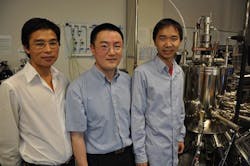Electrically pumped zinc oxide nanowire laser has conventional, rather than random laser emission

Riverside, CA--Finally, a zinc oxide (ZnO) laser has been created that is not only electrically pumped, but has a Fabry-Perot (F-P) cavity. Previous ZnO lasers have mostly consisted of disordered collections of nanocrystals that lase randomly (with cavities formed by looped random reflections), which is interesting in its own way, but has a both spatially and spectrally unpredictable diffuse output that is not practical for most uses. In contrast, the new room-temperature F-P nanowire-waveguide antimony-doped ZnO laser, created by an international team of researchers, shows highly stable laser output.1
As a semiconductor gain material, ZnO is especially important because it has a naturally wide bandgap and large exciton binding energy that place its optical output in the UV. Conventional UV semiconductor lasers are based on gallium nitride, but the ZnO laser created by Jianlin Liu and his colleagues at the University of California, Riverside and others can lead to smaller device sizes, lower costs, higher powers, and shorter wavelengths.
The team also includes researchers from Fudan University in China, the University of Central Florida, and Dalian University of Technology in China.
Antimony doping creates p-type material
Until now, ZnO nanowires couldn't be used in real-world light-emission applications because of the lack of p-type material. Liu solved this problem by doping the ZnO nanowires with antimony. Combined with n-type ZnO thin films, the nanowires form the required p-n junction diode; as a result of the geometry, highly directional laser light emits only from the ends of the nanowires.
"People in the zinc oxide research community throughout the world have been trying hard to achieve this for the past decade," Liu said. "This discovery is likely to stimulate the whole field to push the technology further."
Uses include future DVD writers and players, wireless data transmission, nanobiology, and water purification; Liu says more work needs to be done on the stability and reliability of the p-type ZnO material.
REFERENCE:
1. Sheng Chu et al., Nature Nanotechnology (2011), published online 03 July 2011; doi:10.1038/nnano.2011.97.
Subscribe now to Laser Focus World magazine; it's free!
About the Author
John Wallace
Senior Technical Editor (1998-2022)
John Wallace was with Laser Focus World for nearly 25 years, retiring in late June 2022. He obtained a bachelor's degree in mechanical engineering and physics at Rutgers University and a master's in optical engineering at the University of Rochester. Before becoming an editor, John worked as an engineer at RCA, Exxon, Eastman Kodak, and GCA Corporation.
